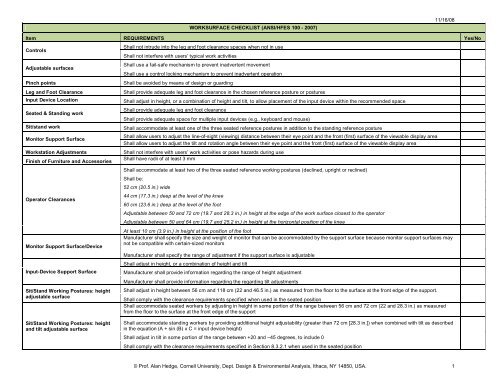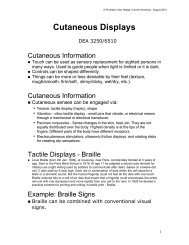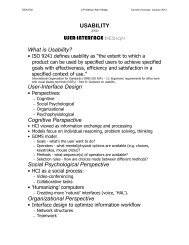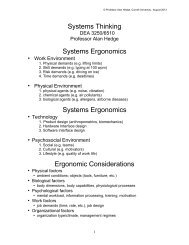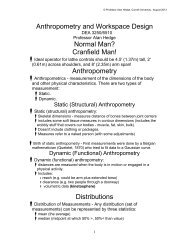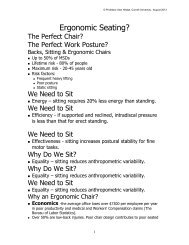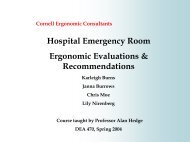to download the Ergonomic Worksurface Evaluation Checklist
to download the Ergonomic Worksurface Evaluation Checklist
to download the Ergonomic Worksurface Evaluation Checklist
- No tags were found...
Create successful ePaper yourself
Turn your PDF publications into a flip-book with our unique Google optimized e-Paper software.
WORKSURFACE CHECKLIST (ANSI/HFES 100 - 2007)<br />
11/16/08<br />
Item REQUIREMENTS Yes/No<br />
Controls<br />
Adjustable surfaces<br />
Pinch points<br />
Leg and Foot Clearance<br />
Input Device Location<br />
Seated & Standing work<br />
Sit/stand work<br />
Moni<strong>to</strong>r Support Surface<br />
Workstation Adjustments<br />
Finish of Furniture and Accessories<br />
Opera<strong>to</strong>r Clearances<br />
Moni<strong>to</strong>r Support Surface/Device<br />
Input-Device Support Surface<br />
Sit/Stand Working Postures: height<br />
adjustable surface<br />
Shall not intrude in<strong>to</strong> <strong>the</strong> leg and foot clearance spaces when not in use<br />
Shall not interfere with users’ typical work activities<br />
Shall use a fail-safe mechanism <strong>to</strong> prevent inadvertent movement<br />
Shall use a control locking mechanism <strong>to</strong> prevent inadvertent operation<br />
Shall be avoided by means of design or guarding<br />
Shall provide adequate leg and foot clearance in <strong>the</strong> chosen reference posture or postures<br />
Shall adjust in height, or a combination of height and tilt, <strong>to</strong> allow placement of <strong>the</strong> input device within <strong>the</strong> recommended space<br />
Shall provide adequate leg and foot clearance<br />
Shall provide adequate space for multiple input devices (e.g., keyboard and mouse)<br />
Shall accommodate at least one of <strong>the</strong> three seated reference postures in addition <strong>to</strong> <strong>the</strong> standing reference posture<br />
Shall allow users <strong>to</strong> adjust <strong>the</strong> line-of-sight (viewing) distance between <strong>the</strong>ir eye point and <strong>the</strong> front (first) surface of <strong>the</strong> viewable display area<br />
Shall allow users <strong>to</strong> adjust <strong>the</strong> tilt and rotation angle between <strong>the</strong>ir eye point and <strong>the</strong> front (first) surface of <strong>the</strong> viewable display area<br />
Shall not interfere with users’ work activities or pose hazards during use<br />
Shall have radii of at least 3 mm<br />
Shall accommodate at least two of <strong>the</strong> three seated reference working postures (declined, upright or reclined)<br />
Shall be:<br />
52 cm (20.5 in.) wide<br />
44 cm (17.3 in.) deep at <strong>the</strong> level of <strong>the</strong> knee<br />
60 cm (23.6 in.) deep at <strong>the</strong> level of <strong>the</strong> foot<br />
Adjustable between 50 and 72 cm (19.7 and 28.3 in.) in height at <strong>the</strong> edge of <strong>the</strong> work surface closest <strong>to</strong> <strong>the</strong> opera<strong>to</strong>r<br />
Adjustable between 50 and 64 cm (19.7 and 25.2 in.) in height at <strong>the</strong> horizontal position of <strong>the</strong> knee<br />
At least 10 cm (3.9 in.) in height at <strong>the</strong> position of <strong>the</strong> foot<br />
Manufacturer shall specify <strong>the</strong> size and weight of moni<strong>to</strong>r that can be accommodated by <strong>the</strong> support surface because moni<strong>to</strong>r support surfaces may<br />
not be compatible with certain-sized moni<strong>to</strong>rs<br />
Manufacturer shall specify <strong>the</strong> range of adjustment if <strong>the</strong> support surface is adjustable<br />
Shall adjust in height, or a combination of height and tilt<br />
Manufacturer shall provide information regarding <strong>the</strong> range of height adjustment<br />
Manufacturer shall provide information regarding <strong>the</strong> regarding tilt adjustments<br />
Shall adjust in height between 56 cm and 118 cm (22 and 46.5 in.) as measured from <strong>the</strong> floor <strong>to</strong> <strong>the</strong> surface at <strong>the</strong> front edge of <strong>the</strong> support.<br />
Shall comply with <strong>the</strong> clearance requirements specified when used in <strong>the</strong> seated position<br />
Shall accommodate seated workers by adjusting in height in some portion of <strong>the</strong> range between 56 cm and 72 cm (22 and 28.3 in.) as measured<br />
from <strong>the</strong> floor <strong>to</strong> <strong>the</strong> surface at <strong>the</strong> front edge of <strong>the</strong> support<br />
Sit/Stand Working Postures: height<br />
and tilt adjustable surface<br />
Shall accommodate standing workers by providing additional height adjustability (greater than 72 cm [28.3 in.]) when combined with tilt as described<br />
in <strong>the</strong> equation (A + sin (B) x C = input device height)<br />
Shall adjust in tilt in some portion of <strong>the</strong> range between +20 and –45 degrees, <strong>to</strong> include 0<br />
Shall comply with <strong>the</strong> clearance requirements specified in Section 8.3.2.1 when used in <strong>the</strong> seated position<br />
© Prof. Alan Hedge, Cornell University, Dept. Design & Environmental Analysis, Ithaca, NY 14850, USA. 1
11/16/08<br />
WORKSURFACE CHECKLIST (ANSI/HFES 100 - 2007)<br />
Item RECOMMENDATIONS Yes/No<br />
Device cabling<br />
Leg and Foot Clearance<br />
Horizontal Work Envelope<br />
Moni<strong>to</strong>r Support Surface<br />
Workstation Adjustments<br />
Finish of Furniture and<br />
Accessories<br />
Surface Gloss<br />
Should be placed <strong>to</strong> avoid interference with <strong>the</strong> operation of workstation components<br />
Should be placed <strong>to</strong> avoid creating hazards for people or equipment in <strong>the</strong> workstation<br />
Should not hinder <strong>the</strong> foot, leg, or knee in alternative or auxiliary (non-VDT) work positions<br />
Should accommodate <strong>the</strong> user postural design criteria:<br />
elbow angles between 70 and 135 degrees<br />
shoulder abduction angles less than 20 degrees<br />
shoulder flexion angles less than 25 degrees<br />
wrist flexion angles less than 30 degrees<br />
wrist extension angles less than 30 degrees<br />
<strong>to</strong>rso-<strong>to</strong>-thigh angles equal <strong>to</strong> or greater than 90 degrees<br />
Should be at least 70 cm (27.6 in.) wide<br />
Should locate <strong>the</strong> most commonly used objects in <strong>the</strong> primary work zone<br />
Should allow users with normal visual capabilities <strong>to</strong> adjust <strong>the</strong> line-of-sight (viewing) distance between <strong>the</strong>ir eyes and <strong>the</strong> front (first)<br />
surface of <strong>the</strong> viewable display area within <strong>the</strong> range of 50 <strong>to</strong> 100 cm (19.7 <strong>to</strong> 39.4 in.)<br />
Should be usable by users while in <strong>the</strong> relevant reference postures<br />
Secondary user contact edges should have radii of at least 2 mm<br />
Should have a matte finish that provides a specular reflectance of no more than 45 gloss units at an angle of 60 degrees as<br />
measured with instruments and procedures that conform <strong>to</strong> ASTM D523-89 (1999), Standard Test Method for Specular Gloss<br />
(American Society for Testing and Materials, 1999).<br />
Work surface<br />
Moni<strong>to</strong>r Support Surface/Device<br />
Input-Device Support Surface<br />
Should be at least 70 cm (27.6 in.) wide<br />
Depth should allow a viewing distance of at least 50 cm (19.7 in.)<br />
Depth should allow positioning of <strong>the</strong> moni<strong>to</strong>r so that <strong>the</strong> angle between <strong>the</strong> horizontal level of <strong>the</strong> eyes and <strong>the</strong> center of <strong>the</strong> screen<br />
ranges between 15 and 25 degrees<br />
Depth should allow positioning of <strong>the</strong> entire viewing area (e.g., including <strong>the</strong> keyboard) in an arc 60 degrees below horizontal eye<br />
level<br />
Should be designed so as <strong>to</strong> allow placement of <strong>the</strong> viewing area of <strong>the</strong> screen at a minimum viewing distance of 50 cm (19.7 in.)<br />
Should be designed so as <strong>to</strong> allow placement of <strong>the</strong> moni<strong>to</strong>r’s viewing area below <strong>the</strong> user’s horizontal eye height<br />
Should be stable during use<br />
Should not interfere with <strong>the</strong> user’s ability <strong>to</strong> adjust <strong>the</strong> height, tilt, and rotation of <strong>the</strong> moni<strong>to</strong>r<br />
Should adjust fore and aft in <strong>the</strong> horizontal plane<br />
Should adjust in side-<strong>to</strong>-side placement within <strong>the</strong> optimal area for input devices<br />
Should tilt<br />
© Prof. Alan Hedge, Cornell University, Dept. Design & Environmental Analysis, Ithaca, NY 14850, USA. 2


